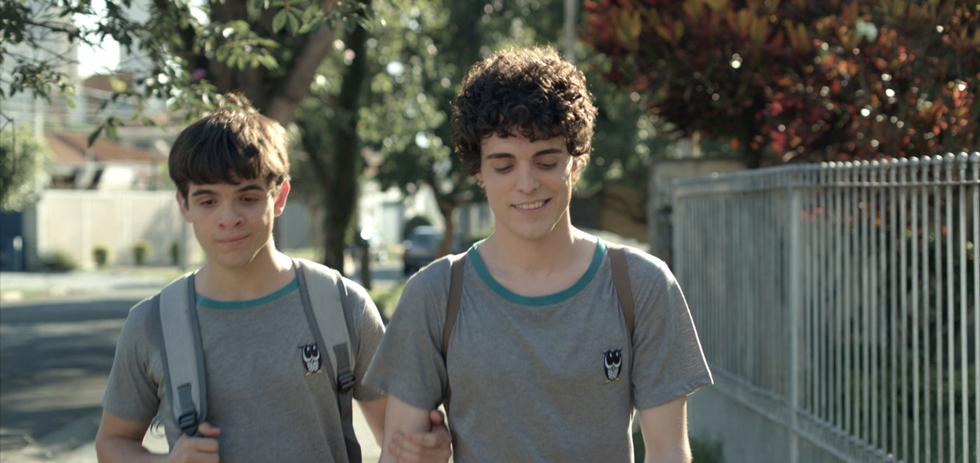
Queer film has a historically complicated relationship to the disabled body, avoiding the stories of queer persons with disabilities that do not fit comfortably into the reactively erotic world of male gay cinema, with its still-felt inheritance from early physique films. In the post-AIDS crisis of queer cinema there is a resurging celebration of traditionally beautiful and hyper masculine healthy bodies that defy the trope of the pity-evoking afflicted and long-suffering queer. The disabled character, Hollywood’s favourite moral metaphor, seen as desexualised and childlike is thus largely ignored by LGBT filmmakers. With his beautiful debut feature, The Way He Looks, Daniel Ribeiro gracefully universalizes the gay disabled experience, with a rare representation of an unsanitized sexual and romantic autonomy.
The film, which evolved out of the well-received 2010 short I Don’t Want To Go Back Alone, follows Leo, a vision impaired teenager, and his budding friendship-turned-romance with the new boy in school, Gabriel. A coming-of-age story at its heart, the film interweaves the usual makers of teen films – parties, first drinking experiences, spin the bottle, school camp shenanigans – with Leo’s specific experience as both blind and queer. The film departs from the younger innocence of the short and delves more into sexuality; which is interestingly never categorized as neither Leo or Gabriel’s admissions of feeling involve an identifiable ‘coming out’ beyond expressing affection for one another. There is no great melodrama at the heart of this film, and while both characters struggle with their sexuality, the response from the outside is largely benign. The sexuality in the film is incredibly tender as the platonic tactile intimacy between the boys awakens, due to the physical nature of their interactions, as Gabriel holding onto Leo’s arm guides him home each day.1
The understated tone runs throughout the film, which refuses to play into the usual blind character romance narratives, where Leo would conventionally be positioned as the mysterious Other to the able bodied character. There is none of the cringeworthy sensationalism of the 1999 Val Kilmer-starring At First Sight, in which the vision impaired person is exoticised for their different and ‘virtuous’ experience of the world. Leo isn’t represented as extraordinarily noble and is not used to inspire the able-bodied audience member. At many moments Leo is, like all angsty teenagers at one point or another, a bit of a dickhead. He neglects his friendship with Giovanna when he is consumed by his tortuous feelings and is bratty and crude in his resistance to his mother’s overbearing nature. His struggle to define himself as his own person speaks less to a motivational drama of the disabled facing obstacles and more to the common 15-year-old’s fight for independence.
The film uses a clean fresh aesthetic with a sustained soft focus and desaturated colour palette. There are several stunning moments where the soft focus is pushed to a striking painterly extreme. The abstract vision of Leo practicing kissing against the glass of his shower, the sliver of light on Leo’s ear in the movie theatre as Gabriel whispers retelling the on-screen action, and the blurred dance of the schoolyard bullies’ arms flailing around Leo’s head all confirm Kerchove’s subtle brilliance as a cinematographer, whose restraint makes the brief lush images all the more memorable.
I am hesitant to praise the authenticity of the Ghilherme Lobo’s performance as a sighted actor playing a blind character. We have a history of over-celebrating cis-gender, able-bodied, heterosexual actors when they convincingly play society’s eternal deviants – queers, junkies, trans people, the disabled – which further alienates the marginalised from their own stories, as we are being told it is such a feat for an actor to empathise with and represent us. The ethics of representation and what actors should play what roles is a larger debate for another time. So without fully opening that can of worms, I will say Lobo’s formal training as a ballet dancer comes very much to his aid in portraying a character with such a precise physicality. His performance, along with those of Fabio Audi as Gabriel and Tess Amorim as Giovana, is natural and charming, with a refreshing bambi naivety that feels authentic in a way that mainstream cinema’s confidently sexual teenagers often do not.
The Way He Looks is heart-warming, adorable, incredibly sweet and a whole range of other nauseating synonyms that would usually send this moviegoer running for the hills. Ribeiro’s sensitive film somehow resists my natural cynicism, being so frankly endearing and thoroughly enjoyable to watch. Echoing the sentiments of the middle-aged man sitting behind me who cooed “Finally!” when the two leads kiss for the first time, this film comes as a welcome and long-awaited addition to the very small canon that deals with characters who stand at the intersections of queerness and disability, while also feeling remarkably relatable to anyone who has been a teenager with a crush.
